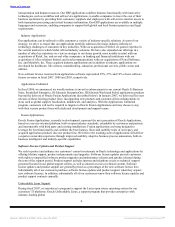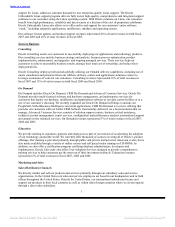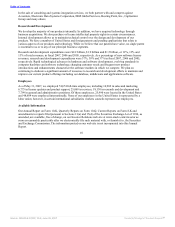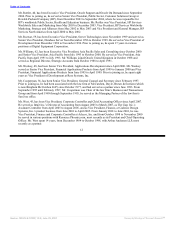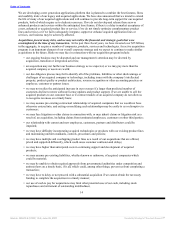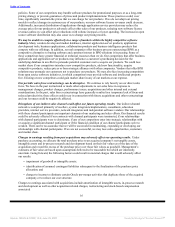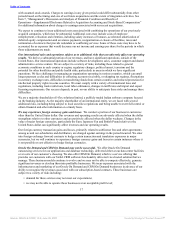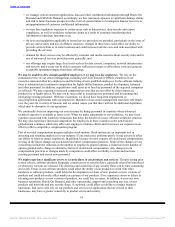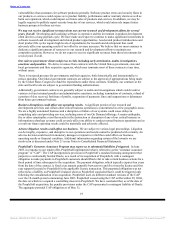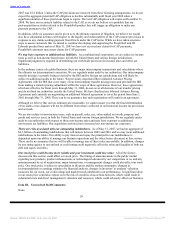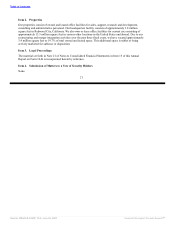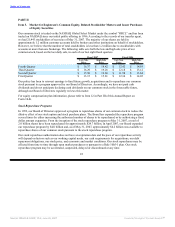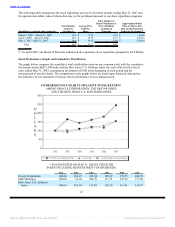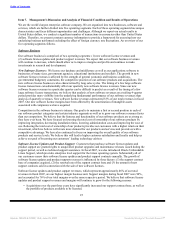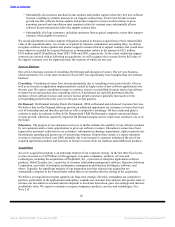Oracle 2006 Annual Report Download - page 20
Download and view the complete annual report
Please find page 20 of the 2006 Oracle annual report below. You can navigate through the pages in the report by either clicking on the pages listed below, or by using the keyword search tool below to find specific information within the annual report.
Table of Contents
policies. Some of our competitors may bundle software products for promotional purposes or as a long-term
pricing strategy or provide guarantees of prices and product implementations. These practices could, over
time, significantly constrain the prices that we can charge for our products. If we do not adapt our pricing
models to reflect changes in customer use of our products, our new software license revenues could decrease.
Additionally, increased distribution of applications through application service providers may reduce the
average price for our products or adversely affect other sales of our products, reducing new software license
revenues unless we can offset price reductions with volume increases or lower spending. The increase in open
source software distribution may also cause us to change our pricing models.
We may be unable to compete effectively in a range of markets within the highly competitive software
industry. Many vendors develop and market databases, internet application server products, application
development tools, business applications, collaboration products and business intelligence products that
compete with our offerings. In addition, several companies offer business process outsourcing (BPO) as a
competitive alternative to buying software and customer interest in BPO solutions is increasing. Some of
these competitors have greater financial or technical resources than we do. Our competitors that offer business
applications and application server products may influence a customer’s purchasing decision for the
underlying database in an effort to persuade potential customers not to acquire our products. We could lose
market share if our competitors introduce new competitive products, add new functionality, acquire
competitive products, reduce prices or form strategic alliances with other companies. Vendors that offer BPO
solutions may persuade our customers not to purchase our products. We may also face increasing competition
from open source software initiatives, in which competitors may provide software and intellectual property
free. Existing or new competitors could gain market share in any of our markets at our expense.
Our periodic sales force restructurings can be disruptive. We continue to rely heavily on our direct sales
force. We have in the past restructured or made other adjustments to our sales force in response to
management changes, product changes, performance issues, acquisitions and other internal and external
considerations. In the past, sales force restructurings have generally resulted in a temporary lack of focus and
reduced productivity; these effects could recur in connection with future acquisitions and other restructurings
and our revenues could be negatively affected.
Disruptions of our indirect sales channel could affect our future operating results. Our indirect channel
network is comprised primarily of resellers, system integrators/implementers, consultants, education
providers, internet service providers, network integrators and independent software vendors. Our relationships
with these channel participants are important elements of our marketing and sales efforts. Our financial results
could be adversely affected if our contracts with channel participants were terminated, if our relationships
with channel participants were to deteriorate, if any of our competitors enter into strategic relationships with
or acquire a significant channel participant or if the financial condition of our channel participants were to
weaken. There can be no assurance that we will be successful in maintaining, expanding or developing our
relationships with channel participants. If we are not successful, we may lose sales opportunities, customers
and market share.
Charges to earnings resulting from past acquisitions may adversely affect our operating results. Under
purchase accounting, we allocate the total purchase price to an acquired company’s net tangible assets,
intangible assets and in-process research and development based on their fair values as of the date of the
acquisition and record the excess of the purchase price over those fair values as goodwill. Management’s
estimates of fair value are based upon assumptions believed to be reasonable but which are inherently
uncertain. Going forward, the following factors could result in material charges that would adversely affect
our results:
• impairment of goodwill or intangible assets;
• identification of assumed contingent liabilities subsequent to the finalization of the purchase price
allocation; and
• charges to income to eliminate certain Oracle pre-merger activities that duplicate those of the acquired
company or to reduce our cost structure.
Charges to earnings associated with acquisitions include amortization of intangible assets, in-process research
and development as well as other acquisition related charges, restructuring and stock-based compensation
associated
16
Source: ORACLE CORP, 10-K, June 29, 2007 Powered by Morningstar® Document Research℠


